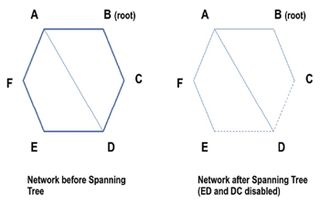Dear Professor Phil,
We’re using IPTV at our school and have discovered a situation that we don’t understand. The video is delivered over a group of Ethernet switches. When we investigate the individual links, we find some links carry large amounts of traffic, while others transport no traffic at all. Can you offer a possible explanation?
Barry, Alexandria, VA
- Barry,
A very likely explanation is that the switches have a loop circuit within them and the spanning tree process has automatically disabled a link. That’s not bad. In fact, it is a very necessary requirement.

The spanning tree algorithm is used with Ethernet switches to routinely remove loop circuits. If these loops weren’t removed, a single IP packet carrying video could loop endlessly while consuming valuable bandwidth. To understand essentially how spanning tree works, look at the diagram of a hypothetical network of switches. The simple hexagon with a diagonal has three loops in it: A-D-E-F-A, A-D-C-B-A, and A-B-C-D-E-F-A.
The spanning tree algorithm picks a switch, say B, to be the root of a tree that will be formed. A series of spanning tree messages is sent over the links starting from the root switch, B. These messages allow the switches to discover that a loop exists. For example, in our drawing, switch E received messages from both F and D. Therefore, E disables the link to one of them, say the one to D. In the same manner, C chooses to disable its link to D. After these two operations, the loops are eliminated and the entire structure forms a tree. Now every switch is connected to every other switch through exactly one path. Occasionally, technicians disable the spanning tree operation to reduce traffic, but that is almost always a bad idea.
Phil Hippensteel, Ph.D., has spent more than forty years in higher education and now teaches at Penn State Harrisburg.










